A chemical compound found in cannabis and produced by the human body that interacts with our bodies’ receptors. Endocannabinoids, or internally produced cannabinoids, are an essential component of our bodies’ endocannabinoid system (ECS), which is largely responsible for maintaining internal balance. Phytocannabinoids, or marijuana cannabinoids produced by the cannabis plant, mimic the functions of our endocannabinoids and are responsible for the euphoric effects associated with THC.
Classes of cannabinoids
The cannabinoids are separated into the following subclasses:
- Cannabigerols (CBG)
- Cannabichromenes (CBC)
- Cannabidiol (CBD)
- Tetrahydrocannabinol (THC)
- Cannabinol (CBN)
- Cannabinodiol (CBDL)
- Other cannabinoids including cannabicyclol (CBL), cannabielsoin (CBE) and cannabitriol (CBT)
Tetrahydrocannabinolic Acid
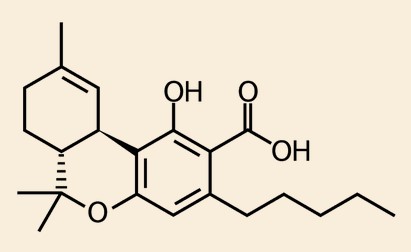
Tetrahydrocannabinolic Acid (THCA) is a non-psychoactive cannabinoid. THC-A is the most abundant cannabinoid in raw cannabis. When THC-A is heated to a high enough temperature, it immediately converts to THC. This process, called decarboxylation, also occurs naturally as fresh cannabis dries and cures. Decarboxylation is simply what happens when carbon dioxide is released from the plant. Some patients juice raw cannabis to access the benefits of medical marijuana without consuming THC. Additionally, exposure to air for extended periods of time can cause THC-A to lose hydrogen atoms. When this occurs, THC-A can convert to cannabinol acid (CBN-A). Like THC-A is the precursor to THC, CBN-A is the precursor to the cannabinoid CBN.
A 2011 study found that THC-A was able to inhibit two enzymes, COX-1 and COX-2, that contribute to symptoms like fever, pain, and swelling. Anti-inflammatory medications, like aspirin, are taken to target these enzymes. The study showed that THC-A was able to inhibit these enzymes by up to 30%, illustrating significant anti-inflammatory properties. The compound has also illustrated antiemetic and neuroprotectant activity in certain studies. A 2018 study discovered that THC-A was able to induce apoptotic cell death in colon cancer and polyp cells, suggesting possible future therapeutic value as an anti-tumor agent.
Tetrahydrocannabivarin
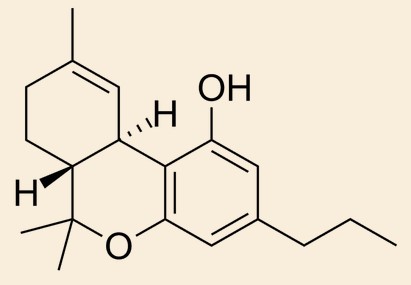
Tetrahydrocannabivarin (THC-V) is a potentially potent psychoactive cannabinoid. Research studies are examining its effects on certain psychological conditions such as PTSD. It may have anxiolytic properties and has also shown promise as a potentially effective treatment for certain types of psychosis. Limited rodent studies have indicated that THC-V can decrease appetite.
Delta-9-tetrahydrocannabinol
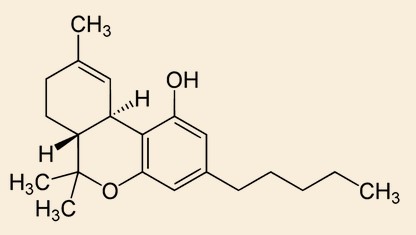
Delta-9-tetrahydrocannabinol (THC) is the most well-known cannabinoid and the main psychoactive compound in cannabis. While the intoxicating effect of THC was the first realized benefit of cannabis, extensive studies have found vast medical benefits of the compound. It is a fairly versatile cannabinoid. Notably, THC has significant antiemetic effects. Many cancer patients use it to reduce nausea and vomiting associated with chemotherapy treatments. It can also be used to stimulate appetite, making it a useful medical agent for wasting syndrome and anorexia.
THC may be especially beneficial for pain management. The analgesic properties may be useful for treating chronic pain stemming from multiple conditions. Patients struggling with sleep-related issues may also benefit from THC. Studies have found that the compound can reduce rapid eye movement during sleep which could help limit PTSD-related nightmares, providing more restful sleep. Many patients also claim that it helps them fall asleep easily. Other common uses may include protecting the nervous system, reducing muscle spasms and providing a sense of relaxation and stress relief.
Cannabidiol
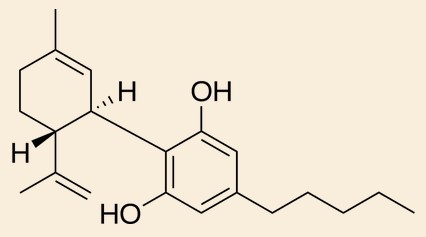
Cannabidiol (CBD) is another cannabinoid extracted from marijuana. However, it has no psychoactive properties. Cannabidiol can decrease the effects of THC. Because of this, scientists are evaluating their therapeutical advantages. Up to date, evidence shows that it can be used to decrease inflammation, relieve muscle spasms, alleviate certain psychotic disorders, and reduce epileptic seizures. Additionally, it has antioxidant capabilities.
CBD is commercialized as oil and topical presentations (lotions, creams, and ointments) in certain parts of the world. Since it has no psychoactive effects, it is legal for possession and purchase as long as it has a concentration of 0.3%.
Cannabinol
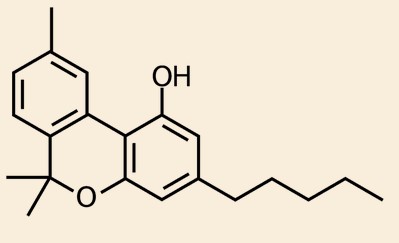
Cannabinol (CBN) naturally occurs when cannabis is exposed to heat and light. It’s typically found in amounts of less than 1%. It is known to have very minimal psychoactive properties. There is very limited research on CBN to date.
Cannabigerol
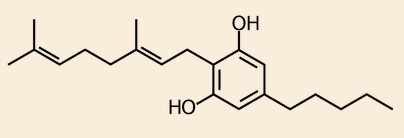
Cannabigerol (CBG) is a non-intoxicating cannabinoid that is found in minimal amounts (less than 1%) in medical marijuana. CBG is the chemical precursor to THC and CBD. CBG has indicated potential in chronic pain management. One study found that CBG may have potential as an anti-cancer agent. Along with THC-A, the compound was able to inhibit the growth of colorectal cancer cells in mice which slowed the colon cancer growth. It was also able to block receptors that cause cancer cell growth. This is very preliminary research that warrants further research, but medical studies are still a long way from proving CBG’s efficacy as an anticancer agent in humans.
What foods contain cannabinoids?
Cacao is rich in anandamide — an endogenous cannabinoid that regulates mood, memory, appetite, and pain perception. Italian researchers also recently discovered that Black truffles are rich in anandamide. Kava, a medicinal tea from the Pacific islands, is rich in kavalactones — compounds that interact directly with CB1 receptors. This may account for kava’s long-standing reputation as a natural remedy for anxiety and pain. Several flowers — including helichrysum, coneflower, electric daisy, and Japanese liverwort — also contain phytocannabinoids, or other compounds that interact with the body’s cannabinoid receptors, or both.
What do cannabinoids do to the body?
Cannabinoids have a wide variety of effects on the body, all of which occur upon the activation of cannabinoid receptors. Cannabinoids that serve both medicinal and recreational purposes change the way we feel, and they have regulatory effects on several body functions. Every function in the body requires a specific balance of factors to perform at optimal capacity. When the body achieves this balance, it’s called homeostasis. Cannabinoids interact with receptors to trigger homeostatic responses throughout the body.
Effects on the nervous system
Cannabinoids trigger responses in the central nervous system largely through their interactions with CB1 receptors. There are CB2 receptors on immune systemcells in the brain as well, but their role and effect aren’t yet fully understood. Because our bodies already use cannabinoid molecules to regulate many functions, they’re inherently endowed with many targets that the cannabis plant can activate. The central nervous system is the main hub of the body’s CB1 receptors where they regulate a wide variety of brain functions.
CB1 receptors are the most widely expressed protein of their kind in the brain. They regulate the release of other neurotransmitters, such as serotonin, dopamine, and glutamate. CB1 receptors are responsible for the euphoric effects of cannabis, but they also play a critical role in the brain’s top-down control of pain.
Peripheral effects
Though not as prominent throughout the nervous system as CB1, CB2 receptors are found in some brain cells, playing a role in pain relief, inflammation control, and preserving the structure of nerve cells. But they’re mostly found on immune cells circulating throughout the body and brain via the bloodstream. CB2 receptors are present enough throughout the body to potentially mediate the damage caused by many human diseases, including those affecting the skin, bones, liver, lungs, cardiovascular system, and gastrointestinal system. The extent to which cannabinoids affect all of these conditions remains clinically uncertain.
Both CB1 and CB2 receptors provide multiple therapeutic pathways. For example, both receptors are present in the skin, where cannabinoids can potentially intervene to treat a wide variety of skin conditions. Arguably, the most crucial difference between the two is that CB1 receptors are a critical target of intoxication in the brain, while CB2 receptors only elicit non-intoxicating effects. While CBD has at least 14 different mechanisms of action, it doesn’t activate the CB1 receptor like THC, which is why CBD is able to initiate therapeutic effects without intoxicating the user.
As cannabis research slowly expands and medical applications become clearer, consumers should know that everyone’s endocannabinoid system is unique. Our bodies vary greatly in the way they respond to phytocannabinoids. We know the ECS exists, and we know that cannabinoids have therapeutic effects when they bind to cannabinoid receptors. But cannabis is a complex plant, and scientific consensus into its effects on the body remains elusive. Researchers are just beginning to learn exactly how cannabis compounds work together to effect our bodies and change the way we feel.
Cannabidivarin (CBD-V) is a non-intoxicating cannabinoid that has exhibited anticonvulsant effects in certain rodent studies. It is being researched for its potential in treating epilepsy.

Hello. Has anyone successfully used Medical Marijuana to help with their Depression out there? If so, what strain and how was it administered and how often do you use it? Thanks.
I smoke a little super silver haze every so often (like maybe once a fortnight or so?) and it helps my depression pretty well. I find it inspires my creativity too.